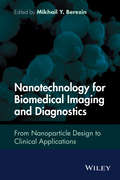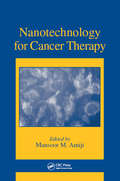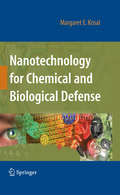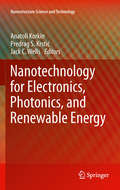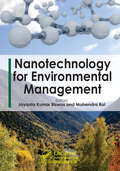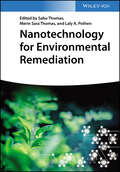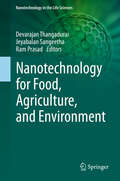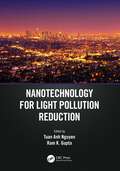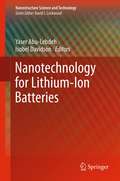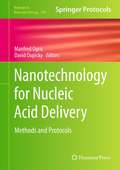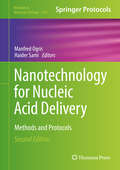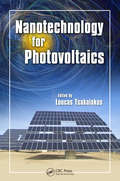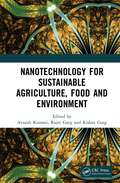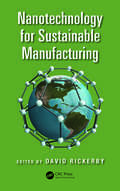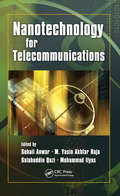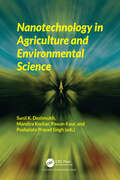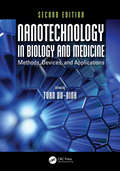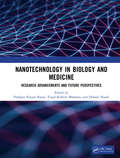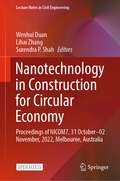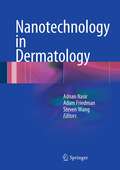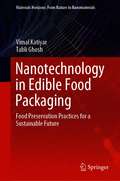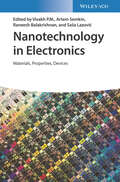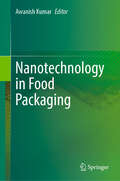- Table View
- List View
Nanotechnology for Biomedical Imaging and Diagnostics: From Nanoparticle Design to Clinical Applications
by Mikhail Y. BerezinNanotechnology for Biomedical Imaging and Diagnostics: From Nanoparticle Design to Clinical Applications reflects upon the increasing role of nanomaterials in biological and medical imaging, presenting a thorough description of current research as well as future directions. With contributions from experts in nanotechnology and imaging from academia, industry, and healthcare, this book provides a comprehensive coverage of the field, ranging from the architectural design of nanomaterials to their broad imaging applications in medicine. Grouped into three sections, the book: Elucidates all major aspects of nanotechnology and bioimaging Provides comprehensive coverage of the field, ranging from the architectural design of nanomaterials to their broad imaging applications in medicine Written by well-recognized experts in academia, industry, and healthcare, will be an excellence source of reference With a multidisciplinary approach and a balance of research and diagnostic topics, this book will appeal to students, scientiests, and healthcare professionals alike
Nanotechnology for Cancer Therapy
by Mansoor M. AmijiWhile simultaneous breakthroughs occurring in molecular biology and nanoscience/technology will ultimately revolutionize all of medicine, it is with our efforts to prevent, diagnose, and treat cancer that many of the most dramatic advances will occur. In support of this potential, the U.S. National Cancer Institute (NCI) established the Alliance fo
Nanotechnology for Chemical Engineers
by Said Salaheldeen Elnashaie Firoozeh Danafar Hassan Hashemipour RafsanjaniThe book describes the basic principles of transforming nano-technology into nano-engineering with a particular focus on chemical engineering fundamentals. This book provides vital information about differences between descriptive technology and quantitative engineering for students as well as working professionals in various fields of nanotechnology. Besides chemical engineering principles, the fundamentals of nanotechnology are also covered along with detailed explanation of several specific nanoscale processes from chemical engineering point of view. This information is presented in form of practical examples and case studies that help the engineers and researchers to integrate the processes which can meet the commercial production. It is worth mentioning here that, the main challenge in nanostructure and nanodevices production is nowadays related to the economic point of view. The uniqueness of this book is a balance between important insights into the synthetic methods of nano-structures and nanomaterials and their applications with chemical engineering rules that educates the readers about nanosclale process design, simulation, modelling and optimization. Briefly, the book takes the readers through a journey from fundamentals to frontiers of engineering of nanoscale processes and informs them about industrial perspective research challenges, opportunities and synergism in chemical Engineering and nanotechnology. Utilising this information the readers can make informed decisions on their career and business.
Nanotechnology for Chemical and Biological Defense
by Margaret KosalThe research underpinning this work was intended to better enable an informed national debate and to affect international debate on the potential role and impact of nanotechnology and emerging science on national defense and homeland security. The text highlights the findings and conclusions from the study and accompanying workshop as well as identifies research directions in basic and applied science that may foster transformational breakthroughs in nanotechnology-based chemical and biological countermeasures. This ambitious effort serves manifold objectives, including the following: * To give policymakers a strategic roadmap to provide a basis for research direction decisions; * To provide an overview of the current and future challenges, both for traditional military operations and for homeland security applications; * To provide a survey of potential future proliferation and malfeasant co-option of emerging technologies; * To discuss organizational structure and management of chemical and biological defense-related research and nanotechnology-related research at the federal level. Throughout, the emphasis is on revolutionary rather than evolutionary science and technology. This work intentionally straddles between technical disciplines and social sciences making it truly interdisciplinary. Ideas or work from across the experimental and theoretical physical and life sciences are included. Contributions of social scientists were also actively sought.
Nanotechnology for Electronics, Photonics, and Renewable Energy
by Anatoli Korkin Predrag S. Krstić Jack C. WellsThis book presents nanotechnology fundamentals and applications in the key research areas of information technology (electronics and photonics) and alternative (solar) energy. Three major technology areas - electronics, photonics and solar energy -- are linked on the basis of similar applications of nanostructured materials in research and development. By bridging the materials physics and chemistry at the atomic scale with device and system design, integration, and performance requirements, tutorial chapters from worldwide leaders in the field provide a coherent picture of theoretical and experimental research efforts and technology development in these highly interdisciplinary areas. The tutorials combine the treatment of fundamentals with discussion of some of the critical challenges facing science and technology today.
Nanotechnology for Environmental Management
by Mahendra Rai Jayanta Kumar Biswas"Nanotechnology for Environmental Management" is your gateway to the latest advancements in environmental science and technology. Edited by leading international scientists, this book delves into the diverse approaches and applications of nanomaterials and nanotechnologies, offering insights into their potential for environmental remediation, energy management, and sustainable development. Each chapter showcases cutting-edge innovations, making this book an essential reference for students, researchers, scientists, technicians, and professionals in environmental management and regulation.Explore the promises and challenges of nanotechnology in addressing environmental issues, and gain valuable perspectives on the future of sustainable development. With its thorough examination of state-of-the-art nanotechnological solutions, "Nanotechnology for Environmental Management" is your indispensable guide to navigating the complexities of environmental science and technology.
Nanotechnology for Environmental Remediation
by Sabu Thomas Merin Sara Thomas Laly A. PothenNanotechnology for Environmental Remediation Comprehensive resource on using nanomaterials to alleviate environmental pollution Contaminated land, soil and water pose a threat to the environment and health. These sites require immediate action in terms of assessing pollution and new remediation strategies. Nanotechnology for Environmental Remediation helps readers understand the potential of nanotechnology in resolving the growing problem of environmental contamination. The specific aim of this book is to provide comprehensive information relating to the progress in the development of functional nanomaterials and nanocomposites which are used for the environmental remediation of a variety of contaminants. The work deals with the different aspects of nanotechnology in water, air and soil contamination and presents the recent advances with a focus on remediation. Core topics discussed in the work include: Nanotechnology that can be used to engineer and tailor particles for specific environmental remediation applications A big-picture conceptual understanding of environmental remediation methods for researchers, environmentalists and professionals involved in assessing and developing new nano-based strategies A detailed approach towards the different remediation procedures by various nanomaterials such as metal nanoparticles, polymeric nanoparticles, carbon nanotubes, and dendrimers The societal impact that nanotechnology has on the environment Chemists and biotechnologists can use Nanotechnology for Environmental Remediation as a comprehensive reference work for thoroughly understanding this new type of technology and why it is so important when considering environmental remediation efforts. Due to the practical application of nanotechnologies, environmental organizations and agencies can also both utilize the work to explore new and more effective ways of doing things, both now and into the future as nanotechnology becomes more common.
Nanotechnology for Food, Agriculture, and Environment (Nanotechnology in the Life Sciences)
by Jeyabalan Sangeetha Ram Prasad Devarajan ThangaduraiNanotechnology progresses its concerts and suitability by improving its effectiveness, security and also reducing the impact and risk. Various chapters in this book are written by eminent scientists and prominent researchers in the field of nanotechnology across the world. This book is focused to put emerging techniques forward using nanoparticles for safe and nutritional food production, protecting crops from pests, increasing nutritional value and providing solutions for various environmental issues. The outcome of this book creates a path for wide usage of nanoparticles in food, agriculture and the environment fields. This book has clear and simple illustrations, tables and case studies to understand the content even by non-experts. This book especially deals with the nanotechnology for controlling plant pathogens, food packaging and preservation, agricultural productivity, waste water treatment and bioenergy production. Hence, this book can be adopted and used by many researchers and academicians in the fields of food, agriculture, environment and nanotechnology for catering the needs of sustainable future. The salient features of this book are • Describes nanotechnology as an interdisciplinary and emerging field in life sciences• Useful for researchers in the cutting edge life science related fields of nanoscience, nanobiology and nanotechnology• Deal with various problems in food, agriculture and environmental sector for sustainable solutions through the application of nanotechnology• Supported with illustrations in color, tables and case studies (wherever applicable), and • Contributed and well written by nanotechnology experts from across various disciplines
Nanotechnology for Infectious Diseases
by Saif Hameed Suriya RehmanThis book aims to cover the applications of nanotechnology against human infectious diseases. The chapters of the book discuss the role of nanotechnology in the efficient diagnosis and treatment of these diseases. It explicitly provides an overview of nanodiagnostics for infectious diseases from nanoparticles-based, nanodevice-based, and point-of-care platforms. The book also covers the state-of-the-art review of recent progress in biomimetic and bioengineered nanotherapies to treat infectious diseases. It also presents a nano carrier-based CRISPR/Cas9 delivery system for gene editing and its applications for developing interventional approaches against communicable diseases. Further, it reviews the recent developments in nanotechnology to engineer nanoparticles with desired physicochemical properties as a line of defense against multi-drug resistance micro-organisms. Cutting across the disciplines, this book serves as a guide for researchers in biotechnology, parasitology, and nanotechnology.
Nanotechnology for Light Pollution Reduction
by Ram K. Gupta Tuan Anh NguyenLight is essential for living organisms; however, excessive light causes adverse health conditions. This book covers the most recent progress on nanotechnology for reducing light pollution, discussing many approaches and technologies for controlling light pollution.The book explores the fundamentals of light and the causes of light pollution, delving into light pollution’s social, economic, and ecological impacts, its effects on living beings and the environment, as well as possible solutions and methods of control. The text discusses smart lighting technology, covering the various smart nanomaterials, nanosensors, and nanodevices involved. It also explores smart lighting involving natural light from the sun, artificial skydomes, shadow-free/secondary light sources, and the basics of many emerging devices such as light-emitting diodes and photosensors.Nanotechnology is key to providing a new route for the next generation of lighting devices and systems with reduced light pollution. This essential reference illuminates emerging technologies and their applications, providing new directions to scientists, researchers, and students to better understand the principles, technologies, and applications of nanotechnology in light pollution.
Nanotechnology for Lithium-Ion Batteries
by Isobel Davidson Yaser Abu-LebdehThis book combines two areas of intense interest: nanotechnology, and energy conversion and storage devices. In particular, Li-ion batteries have enjoyed conspicuous success in many consumer electronic devices and their projected use in vehicles that will revolutionize the way we travel in the near future. For many applications, Li-ion batteries are the battery of choice. This book consolidates the scattered developments in all areas of research related to nanotechnology and lithium ion batteries.
Nanotechnology for Nucleic Acid Delivery
by David Oupicky Manfred OgrisNanotechnology and nucleic acid based therapies are two emerging fields in science whose combination has the potential to improve quality of life for patients suffering from various diseases that can so far only be treated in an unsatisfactory way. Nucleic acids offer the potential for highly selective treatment of such diseases or the highly specific modulation of gene expression with RNA interference. A key issue for successful nucleic acid therapies is the availability of a suitable delivery system. Here, the field of nanotechnology offers a multitude of possibilities to develop nanosized delivery vectors tailor-made for various local and systemic approaches. In Nanotechnology for Nucleic Acid Delivery: Methods and Protocols, experts in the field cover the area of nanoparticulate delivery of nucleic acids in terms of biosafety, particle synthesis as well as its application in cell culture. Written in the successful Methods in Molecular BiologyTM series format, chapters include introductions to their respective topics, lists of the necessary materials and reagents, step-by-step, readily reproducible protocols, and notes on troubleshooting and avoiding known pitfalls. Authoritative and easily accessible, Nanotechnology for Nucleic Acid Delivery: Methods and Protocols seeks to serve both professionals and novices with its well-honed methodologies.
Nanotechnology for Nucleic Acid Delivery: Methods and Protocols (Methods in Molecular Biology #1943)
by Manfred Ogris Haider SamiThis detailed second edition volume expands upon the prior edition by addressing newly emerged technologies as well as improved existing protocols in nucleic acid delivery via nanotechnology. The book addresses topics ranging from chemical synthesis of macromolecules and bioconjugates, novel and established nanoformulations, characterization of these nanoformulations for biophysical, biological and toxicological aspects, and also protocols dealing with application and imaging of such carrier systems in vivo. Written for the highly successful Methods in Molecular Biology series, chapters include introductions to their respective chapters, lists of the necessary materials and reagents, step-by-step, readily reproducible laboratory protocols, and tips on troubleshooting and avoiding known pitfalls. Authoritative and up-to-date, Nanotechnology for Nucleic Acid Delivery: Methods and Protocols, Second Edition serves as an ideal guide to researchers seeking to use this vital area of study in their own lab work or to progress knowledge within the field itself.
Nanotechnology for Photovoltaics
by Loucas TsakalakosCurrent concerns regarding greenhouse gas-related environmental effects, energy security, and the rising costs of fossil fuel-based energy has renewed interest in solar energy in general and photovotaics in particular. Exploring state-of-the-art developments from a practical point of view, Nanotechnology for Photovoltaics examines issues in increas
Nanotechnology for Sustainable Agriculture, Food and Environment
by Avnesh KumarNanotechnology has the potential to drastically transform the agri-food sector with its significant applications to improve agricultural productivity and the efficiency of agrochemicals. The food sector has benefitted from the inclusion of nanoparticles in food matrixes and the nanoencapsulation of nutraceuticals. Smart packaging materials designed with the help of nanotechnology have been used for increasing the shelf life of stored food products. Nanomaterials have been extensively used for the delivery of important agrochemicals to enhance their bioefficacy, prevent their degradation, and control their release. Various nanomaterials have been explored for remediation of arising environmental issues. Nanotechnology has also made a useful contribution to the utilization of huge agricultural and food wastes for production of valuable products. The existing and emerging applications of nanotechnology will contribute to environmental sustainability. Nanotechnology for Sustainable Agriculture, Food and Environment has been structured to provide a widespread coverage and up-to-date progress of nanotechnology and its applications in the agri-food sector and environmental remediation. Synthesis of value-added nanomaterials from agri-food wastes and their potential applications in environmental remediation have been explored. In addition, toxicity issues with nanomaterials have also been discussed. Features: 1) Elaborated information on the use of nanotechnology for sustainable agriculture 2) In-depth study about valorization of agri-food waste 3) An overview of applications of nanotechnology in environmental remediation 4) Toxicity analysis of nanotechnology-based products We aim to satisfy the need for a reference book for scientists, researchers, academicians and students in nanotechnology, agricultural, food, nutraceuticals, environmental and material sectors.
Nanotechnology for Sustainable Manufacturing
by David RickerbyNanomaterials have the potential to contribute to more sustainable manufacturing through cleaner, less wasteful production processes and can substitute conventional materials, leading to savings in raw materials and energy. This book provides an innovative perspective by establishing connections between the subject areas associated with nanotechnology and by bridging academic and industrial research. It also covers methods for assessing the sustainability of nanotechnology-based products and processes using life-cycle analysis, taking into account material and energy consumption during manufacture, use, and final disposal and/or recycling.
Nanotechnology for Telecommunications
by Mohammad Ilyas Sohail Anwar M. Yasin Akhtar Raja Salahuddin QaziWith its unique promise to revolutionize science, engineering, technology, and other fields, nanotechnology continues to profoundly impact associated materials, components, and systems, particularly those used in telecommunications. These developments are leading to easier convergence of related technologies, massive storage data, compact storage devices, and higher-performance computing. Nanotechnology for Telecommunications presents vital technical scientific information to help readers grasp issues and challenges associated with nanoscale telecommunication system development and commercialization—and then avail themselves of the many opportunities to be gleaned. This book provides technical information and research ideas regarding the use of nanotechnology in telecommunications and information processing, reflecting the continuing trend toward the use of optoelectronics. Nanotech will eventually lead to a technology cluster that offers a complete range of functionalities for systems used in domains including information, energy, construction, environmental, and biomedical. Describing current and future developments that hold promise for significant innovations in telecommunications, this book is organized to provide a progressive understanding of topics including: Background information on nanoscience and nanotechnology Specific applications of nanotechnology in telecommunications Nanostructured optoelectronic materials MEMS, NEMS, and their applications in communication systems Quantum dot Cellular Automata (QCA) and its applications in telecommunication systems How nonohmic nonlinear behavior affects both digital and analog signal processing Concepts regarding quantum switching and its applications in quantum networks The scale of the physical systems that use nanoscale electronic devices is still large, and that presents serious challenges to the establishment of interconnections between nanoscale devices and the outside world. Also addressing consequent social implications of nanotech, this book reviews a broad range of the nano concepts and their influence on every aspect of telecommunications. It describes the different levels of interconnections in systems and details the standardized assembly process for a broad specrum of micro-, nano-, bio-, fiber-optic, and optoelectronic components and functions. This book is a powerful tool for understanding how to harness the power of nanotech through integration of materials, processes, devices, and applications.
Nanotechnology in Agriculture and Environmental Science
by Pawan Kaur Sunil K. Deshmukh Mandira Kochar Pushplata Prasad SinghThis book provides examples applications of nanotechnology in addressing problems and challenges in agriculture as well as environmental sciences and provides an overview of innovations in nanopesticides, nanofertilizers, bionanosensors and nano-based delivery system for improving different aspects of plant productivity including pre-harvest and post-harvest strategies as well detection of contaminants that could be useful for enhancing soil health. Recycling of agricultural waste to beneficial products using nanotechnologies; bionanosensors; fate of nanomaterials and the ecological consequences of their delivery into the environment; safety and nanotoxicity issues are other topics being dealt with in this book. Chapters have been written by internationally recognized researchers and experts with special reference to the innovations and latest developments in the mentioned areas of nanobiotechnology that have applications and commercial importance, especially for crop fields and post-harvest management. Despite the research and development used to promote the use of nanotechnology in agriculture and the environmental, knowledge gaps and uncertainties about how to fill the gaps are more prevalent than scientific certainties about the public health and environmental effects of nanomaterials. The book thus addresses the issue of toxicity of nanomaterials in agricultural nanotechnology products. The book will be useful for active researchers and scientists in the agricultural sector, academia as well as industry, including nanotechnologists, plant pathologists, agronomists, agrochemists, environmental technologists and all scientists working for sustainability in agriculture. The book will encourage future and active researchers and scientists in the agriculture sector, academia as well as industry.
Nanotechnology in Biology and Medicine: Methods, Devices, and Applications, Second Edition
by Tuan Vo-DinhThe second edition of Nanotechnology in Biology and Medicine is intended to serve as an authoritative reference source for a broad audience involved in the research, teaching, learning, and practice of nanotechnology in life sciences. This technology, which is on the scale of molecules, has enabled the development of devices smaller and more efficient than anything currently available. To understand complex biological nanosystems at the cellular level, we urgently need to develop a next-generation nanotechnology tool kit. It is believed that the new advances in genetic engineering, genomics, proteomics, medicine, and biotechnology will depend on our mastering of nanotechnology in the coming decades. The integration of nanotechnology, material sciences, molecular biology, and medicine opens the possibility of detecting and manipulating atoms and molecules using nanodevices, which have the potential for a wide variety of biological research topics and medical uses at the cellular level. This book presents the most recent scientific and technological advances of nanotechnology for use in biology and medicine. Each chapter provides introductory material with an overview of the topic of interest; a description of methods, protocols, instrumentation, and applications; and a collection of published data with an extensive list of references for further details. The goal of this book is to provide a comprehensive overview of the most recent advances in instrumentation, methods, and applications in areas of nanobiotechnology, integrating interdisciplinary research and development of interest to scientists, engineers, manufacturers, teachers, and students.
Nanotechnology in Biology and Medicine: Research Advancements & Future Perspectives
by Pradipta Ranjan Rauta Yugal Kishore Mohanta Debasis NayakNanotechnology in biology and medicine: Research advancements & future perspectives is focused to provide an interdisciplinary, integrative overview on the developments made in nanotechnology till date along with the ongoing trends and the future prospects. It presents the basics, fundamental results/current applications and latest achievements on nanobiotechnological researches worldwide scientific era. One of the major goals of this book is to highlight the multifaceted issues on or surrounding of nanotechnology on the basis of case studies, academic and theoretical articles, technology transfer (patents and copyrights), innovation, economics and policy management. Moreover, a large variety of nanobio-analytical methods are presented as a core asset to the early career researchers. This book has been designed for scientists, academician, students and entrepreneurs engaged in nanotechnology research and development. Nonetheless, it should be of interest to a variety of scientific disciplines including agriculture, medicine, drug and food material sciences and consumer products. Features It provides a thoroughly comprehensive overview of all major aspects of nanobiotechnology, considering the technology, applications, and socio-economic context It integrates physics, biology, and chemistry of nanosystems It reflects the state-of-the-art in nanotechnological research (biomedical, food, agriculture) It presents the application of nanotechnology in biomedical field including diagnostics and therapeutics (drug discovery, screening and delivery) It also discusses research involving gene therapy, cancer nanotheranostics, nano sensors, lab-on-a-chip techniques, etc. It provides the information about health risks of nanotechnology and potential remedies. It offers a timely forum for peer-reviewed research with extensive references within each chapter
Nanotechnology in Construction for Circular Economy: Proceedings of NICOM7, 31 October–02 November, 2022, Melbourne, Australia (Lecture Notes in Civil Engineering #356)
by Surendra P. Shah Lihai Zhang Wenhui DuanThis open access book covers emerging opportunities and future use of nanotechnology in construction, including deep advances in cement chemistry, nanotechnology, artificial intelligence, robotics, concrete technology, and extreme engineering (blast, impact and fire). The proceedings also presents sectorial interactions within the traditional construction industry supply chain, enabled by the dynamic partnership between international industry, government agencies, and universities. Nanotechnology has transformed the construction materials industry into an advanced manufacturing sector to address climate change and carbon neutrality challenges by delivering sustainable and resilient infrastructure assets. Hence, this book reports specific advances in nanoscience and nano-engineering, and their impacts on numerous novel construction materials including binders, additives, high-performance concrete materials, concrete structural systems, polymer composites, and pavement materials.
Nanotechnology in Dermatology
by Adam Friedman Steven Wang Adnan NasirNanotechnology in Dermatology is the first book of its kind to address all of the important and rapidly growing aspects of nanotechnology as it relates to dermatology. In the last few years there has been an explosion in research and development for products and devices related to nanotechnology, including numerous applications for consumers, physicians, patients, and industry. Applications are underway in medicine and dermatology for the early detection, diagnosis, and targeted therapy of disease, and nanodesigned materials and devices are expected to be faster, smaller, more powerful, more efficient, and more versatile than their traditional counterparts. Written by experts working in this exciting field, Nanotechnology in Dermatology specifically addresses nanotechnology in consumer skin care products, in the diagnosis of skin disease, in the treatment of skin disease, and the overall safety of nanotechnology. The book also discusses future trends of this ever-growing and changing field, providing dermatologists, pharmaceutical companies, and consumer cosmetics companies with a clear understanding of the advantages and challenges of nanotechnology today.
Nanotechnology in Edible Food Packaging: Food Preservation Practices for a Sustainable Future (Materials Horizons: From Nature to Nanomaterials)
by Vimal Katiyar Tabli GhoshThis volume delivers a systematic overview of nanotechnology in the development of edible food packaging with noteworthy characteristics for improved food quality. It covers current research trends, history outlines, and state of the global marketin combination with associated biomaterials and synthesis strategies. The contents detail the use of various emerging bionanostructured materials such as cellulose nanostructures, chitosan nanostructures, and more.It further deliberates an in-depth discussion on various synthesis strategies and routes for the development of edible food packaging in terms of utilizing various nanosystems such as polymeric nanocomposites, nanoencapsulation systems, nanoemulsion systems, and others.Further, it also discusses experimental practices for bionanostructured and edible packaging materials to check the effectivity in terms of offering enhanced shelf life of food products. It also touches upon the socio-techno challenges in-line with developing edible packaging materials using nanotechnology for high performance packaging application. The book is an excellent guide for both the academia and industry especially early career professionals in edible food packaging sectors for selecting proper biomaterial involvingbiofillers, modifiers, cross linkers, compatibilizers and others to enhance the property of edible food packaging for targeted features.^
Nanotechnology in Electronics: Materials, Properties, Devices
by Visakh P. M. Raneesh Balakrishnan Artem Semkin Saša LazovićNanotechnology in Electronics Enables readers to understand and apply state-of-the-art concepts surrounding modern nanotechnology in electronics Nanotechnology in Electronics summarizes numerous research accomplishments in the field, covering novel materials for electronic applications (such as graphene, nanowires, and carbon nanotubes) and modern nanoelectronic devices (such as biosensors, optoelectronic devices, flexible electronics, nanoscale batteries, and nanogenerators) that are used in many different fields (such as sensor technology, energy generation, data storage and biomedicine). Edited by four highly qualified researchers and professionals in the field, other specific sample topics covered in Nanotechnology in Electronics include: Graphene-based nanoelectronics biosensors, including the history, properties, and fundamentals of graphene, plus fundamentals of graphene derivatives and the synthesis of graphene Zinc oxide piezoelectronic nanogenerators for low frequency applications, with an introduction to zinc oxide and zinc oxide piezoelectric nanogenerators Investigation of the hot junctionless mosfets, including an overview of the junctionless paradigm and a simulation framework of the hot carrier degradation Conductive nanomaterials for printed/flexible electronics application and metal oxide semiconductors for non-invasive diagnosis of breast cancer The fundamental aspects and applications of multiferroic-based spintronic devices and quartz tuning fork based nanosensors. Containing in-depth information on the topic and written intentionally to help with the practical application of concepts described within, Nanotechnology in Electronics is a must-have reference for materials scientists, electronics engineers, and engineering scientists who wish to understand and harness the state of the art in the field.
Nanotechnology in Food Packaging
by Awanish KumarFor researchers and food industry professionals seeking a comprehensive, fully up to date single source on nanotechnology in food packaging, this text provides all the needed information. The book begins with a chapter on the current state of nanotechnology and its use in food packaging and the industry as a whole, including current advances in methods and technology. Further chapters address organic nano packaging for shelf life and quality retention, the use of inorganic nanomaterials, biopolymeric nano packaging and composite nano packaging materials. Nanotechnology in Food Packaging focuses on the methods of synthesis for nano-based food packaging materials and the fabrication of improved, active and smart packaging materials. Ethical issues and safety features of nanomaterials are addressed, plus the main challenges and regulatory aspects of nanomaterials in food products. An important chapter looks to the future of nanotechnology in the food packaging industry. Toxicological aspects, detection methods and analysis of nanomaterials are also covered in full. With its wide scope and up to date information on technological advancements, this is the perfect source for those seeking knowledge on the use of nanotechnology in the food industry.
